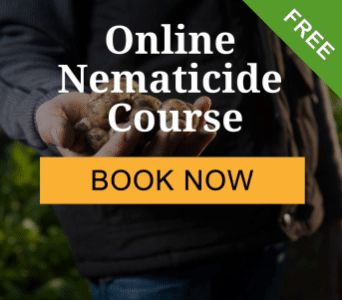1. What are nematodes?
Nematodes are microscopic parasitic worms that live in the soil and cause significant damage to the roots of crops. Potato Cyst Nematode (PCN) invade potato roots and by feeding on the plant cells, damage the roots causing them to grow abnormally. This inhibits the plant’s ability to take up water and nutrients, resulting in poor quality potatoes or, in some circumstances, complete crop loss. Females become the cysts found on roots, or loose in soils, and can contain up to 500 eggs each, therefore perpetuating and multiplying the problem for future potato crops.
2. What are nematicides and what are they used for?
Nematicides fall under the remit of plant protection products (PPPs) used to control nematodes, most importantly PCN. They are applied to the soil at planting and have been used by the agricultural industry in the UK for over 30 years.
3. Is it necessary to control nematodes in the UK?
Nematode control is integral to the production of high quality, nutritious potatoes because of the significant damage to both yield and quality that PCN can cause. According to the AHDB, PCNs are the most significant potato pests in the UK with an estimated damage cost of £50M a year . It is also estimated that up to 65% of UK potato land is infested with the pest.
4. Why is there a nematicide stewardship programme?
It is important that nematicides are applied correctly to protect the consumer, operator and environment. The Nematicide Stewardship Programme (NSP) is an independently managed joint initiative which includes Syngenta, grower representatives and regulatory and government bodies. They aim to ensure that these vital products are applied safely, and remain part of the crop protection toolbox for future use on potatoes.
5. How do nematicides impact on the environment?
Nematicides are designed to disrupt the life processes of nematodes. When used in accordance with the product label instructions, there are minimal risks. However, the Health and Safety Executive, together with the Expert Committee and minister for the environment in the UK, regulate the use of all PPPs to ensure that they do not harm human health or have adverse effects on the environment. They do this by setting strict legal conditions on the way these products can be used. By working with other organisations, they ensure the risk and impact of using PPPs are understood and controlled appropriately.
6. What is being done to ensure these products are used safely?
The NSP has set out industry guidelines, which are included in the Red Tractor protocol, to protect the consumer, operator and environment. In accordance with these guidelines it is recommended that all operators take a nematicide training course to qualify them to apply nematicides.
The NSP in conjunction with NIAB, through its training platform ARTIS, have provided classroom and field courses, which to date have trained 1,330 participants. Since March 2017 the training has been digitalised to allow operators to continue to refresh their knowledge online, while awarding BASIS and NRoSO points.
Best practice guidelines for the use of nematicides:
- Advice must be sought from a BASIS-qualified agronomist prior to the use of nematicides
- Only operators who have a PA4 and 4G qualification, wearing the correct personal protective equipment (PPE), should apply nematicides
- Granule applicators must be calibrated and checked by a qualified engineer every two years and should be checked by the operator prior to each work day
- Nematicides must be applied and incorporated within a single pass
- Granule flow must be shut off at least 3m before the end of the row
- Small spillages should be buried immediately and if larger spillages occur growers should use the original container to hold the product and contact the manufacturer for advice on disposal
- Treated areas should be monitored for any adverse effects to wildlife 24 hours after application and if any are found, growers should contact Natural England and the product manufacturer
For more information on these guidelines, please visit the best practice pages on the NSP website. To sign up to the free online training courses, visit the ARTIS website.
7. Are nematicide applications always justified?
Nematicides should only be applied as part of an integrated strategy when pest pressure has been demonstrated by accurate soil sample data. The AHDB has produced a soil sampling guide to help growers and operators accurately assess their PCN burden, which includes the advice below.
- Divide fields into blocks of one hectare or less for sampling
- Use a corer with a 10-15mm diameter
- Take a minimum of 49 cores/ha in a grid pattern
- Insert the corer to a depth of up to 25cm
- The entire sample should be sent to the laboratory, no sub-sampling should occur in the field
8. What other methods are available to control nematodes?
There are limited alternatives to nematicides. Growers should take an integrated approach to controlling the pest by using nematicides as a last resort, once all cultural controls have been applied, where appropriate. These include:
- Using PCN-free land where possible
- Widening rotations between successive potato crops
- Choosing a variety resistant to PCN
- Controlling volunteer potatoes
- Implementing good hygiene practices to help reduce soil movement, such as waste soil from grading machines
- Using trap crops and/ or biofumigants
9. What is the regulatory process for nematicides?
Like all PPPs, nematicides are subject to renewal as part of an ongoing programme under EC 1107/2009, which on the UK’s exit from the EU, will also be written into UK national law. In addition, as part of the NSP, authorisation holders work closely with the Health and Safety Executive, providing annual reports on stewardship activities with their products. On acceptance of these reports each product is permitted to be sold for a further season.


